Display ads have been a go-to option in digital advertising for many years, and they have been effective.
But native ads have gained popularity since their inception too and provide engaging ways of promoting high-quality sponsored content.
What’s becoming increasingly popular is having a powerful combination of programmatic and native which enables advertisers to promote advertisements that gel well with surrounding content, at scale.
Article to read: 10 tips to stay ahead in digital advertising
What are Display Ads and Programmatic Native Ads?
Display Ads sometimes known as banner ads are creatively designed images or photos that generally appear next to (or near) editorial content. Viewers can click on the ad, a process that typically leads them back to a landing page.
- Programmatic Native Ads: Native ads mimic the look and feel of editorial content and are carefully designed to fit the form and function of the supporting platform. There is a subtle disclaimer like ‘sponsored’ or ‘promoted’ to disclose that they are ads. Programmatic adds more power to native ads by leveraging machine learning and contextual signals to customize them according to user preferences and placing them at appropriate places.
Which one is better?
Display ads have been the main component of any marketer’s paid advertising campaigns, but they are gradually losing steam as the industry is embracing programmatic native ads. What has caused advertisers to be wary of the tried and tested Display Ads? Is programmatic native now the solution to capture the rapidly evolving digital advertising industry? Or is it the end of the road for Display Ads? Here are some thoughts.
- Consumer Experience and Engagement: Programmatic Native Ads win hands-down when it comes to improved consumer experience and engagement. Because Display (banner) Ads scream they are an advertisement, the user gets immune to seeing them and in turn, ignoring them.On the other hand, a Native Ad is creatively crafted to gel well with the content a user is interested in reading. They are ‘native’ to the environment they appear in, and attempt to mimic the surrounding articles and pages. This provides a positive user experience and arouses user interest as they are generally related to the content the user likes to see.
- Efficiency: Programmatic Native Ads do all the hard-work and help you focus more on strategy. The process is systematic and places ads using AI and real-time bidding; thus decisions like the screen where the ad should be placed, the most effective strategy, and more, are all automated. This allows ads to reach target demographics seamlessly. It provides you with data about who your ideal customers are based on their most-used device, geographic and browsing data. You can adjust your CPMs in real time, according to the value of the impression, hence it is cost effective. It helps you scale well in terms of reaching your target audiences. With all these advantages, no doubt the Programmatic-Native combination is more efficient.
- Reaching Multiple Market Segments: Both Display and Programmatic Native work really well when it comes to reaching multiple market segments.Since programmatic native ads are woven with informative content and supported by AI there is a good probability of them going viral. Such ads may even land on audience screens who are not part of the target list owing to shares or re-tweets and likes, hence capturing the attention of viewer beyond the targeted segment. With display ads too, you can set parameters on what sites they appear, the targeted geographical area or the niche market. But targeting a specific audience isn’t all they do. They give you the ability to appear on platforms that have high traffic or sites that are in some way related to your ad. They provide you visibility in front of a high volume of people, even if they aren’t searching.
- Brand Awareness: Programmatic Native ads measureless in terms of Brand Recall as compared to Display Ads. While designing native ads advertisers have to be particular to strategically position the brand logo, because these ads merge so well with the surrounding content, they can easily be missed. But Display Ads are branded and styled in a way that allows the user to gather a lot of information about the offer or brand just by scanning the advertisement.
- Technology Readiness: Since Display Ads have been around since the word go in digital advertising. While there isn’t a high technical know-how required to run Display Ads, a higher investment in technology is needed for Programmatic Native Ads. Advertisers need to produce creative native ads and this can prove to be quiet challenging. Such ads also need remodeling of publisher’s website and not much technology is available right now, for every platform to be able to accommodate Programmatic Native Ads.
Native ads build deeper connections, but require more creative work, while Display Ads have the same static creative on all impressions. In native, creatives are blended with editorial content, but the consumer may feel cheated if the distinction between sponsored content and true editorial content is not clear.
Native ads supported by programmatic seem to be a win-win for all. With audiences using Ad blockers or ignoring ads, Display Ads are no longer a sure shot way to reach the audience. It’s still not the end of Display Ads though, as it will take a lot of time (and investments) to fully migrate to Programmatic Native Ads. And who knows, the user may get immune to them too.
____
by Vandita Grover
Source: martechadvisor.com


